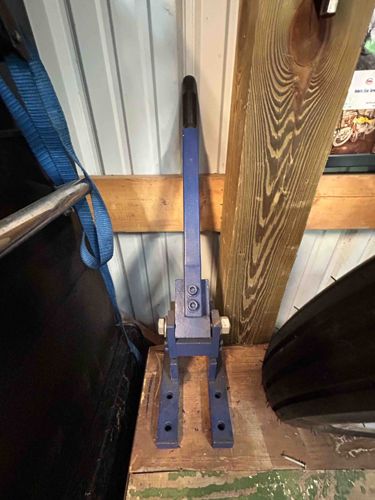
Manual Tire Bead Breaker
The item depicted is a manual tire bead breaker, characterized by its robust construction and utilitarian design. It is primarily composed of heavy-gauge steel, finished in a striking blue powder coating, which exhibits some minor scuffs and chips consistent with use but no severe corrosion. The tool features a long, upright lever arm, culminating in a black, ergonomic rubber or plastic handle for comfortable grip and leverage. This lever connects to a pivoting mechanism, joined by two prominent bolts, which then extends down to a two-pronged base. Each prong of the base has three pre-drilled holes, suggesting it is designed to be bolted down to a workbench or similar sturdy surface for stability during operation. The overall construction appears solid and well-engineered for applying significant force. There are no discernible manufacturer's marks or signatures visible in the provided images, making it difficult to ascertain a specific brand or exact manufacturing origin. The design is typical of tools used for automotive or small engine repair, likely from the late 20th to early 21st century. Its condition indicates it has been used but maintained, showing the expected wear of a functional shop tool rather than significant damage. The quality of craftsmanship appears to be industrial-grade, built for durability and repeated heavy-duty use.
AI-Generated Appraisal Disclaimer
Estimated Value
$100-150
Basic Information
Category
Automotive Tooling
Appraised On
December 7, 2025
Estimated Value
$100-150
Item Description
The item depicted is a manual tire bead breaker, characterized by its robust construction and utilitarian design. It is primarily composed of heavy-gauge steel, finished in a striking blue powder coating, which exhibits some minor scuffs and chips consistent with use but no severe corrosion. The tool features a long, upright lever arm, culminating in a black, ergonomic rubber or plastic handle for comfortable grip and leverage. This lever connects to a pivoting mechanism, joined by two prominent bolts, which then extends down to a two-pronged base. Each prong of the base has three pre-drilled holes, suggesting it is designed to be bolted down to a workbench or similar sturdy surface for stability during operation. The overall construction appears solid and well-engineered for applying significant force. There are no discernible manufacturer's marks or signatures visible in the provided images, making it difficult to ascertain a specific brand or exact manufacturing origin. The design is typical of tools used for automotive or small engine repair, likely from the late 20th to early 21st century. Its condition indicates it has been used but maintained, showing the expected wear of a functional shop tool rather than significant damage. The quality of craftsmanship appears to be industrial-grade, built for durability and repeated heavy-duty use.
Get Your Items Appraised
Instant estimates of your treasures with AI-powered instant appraisals